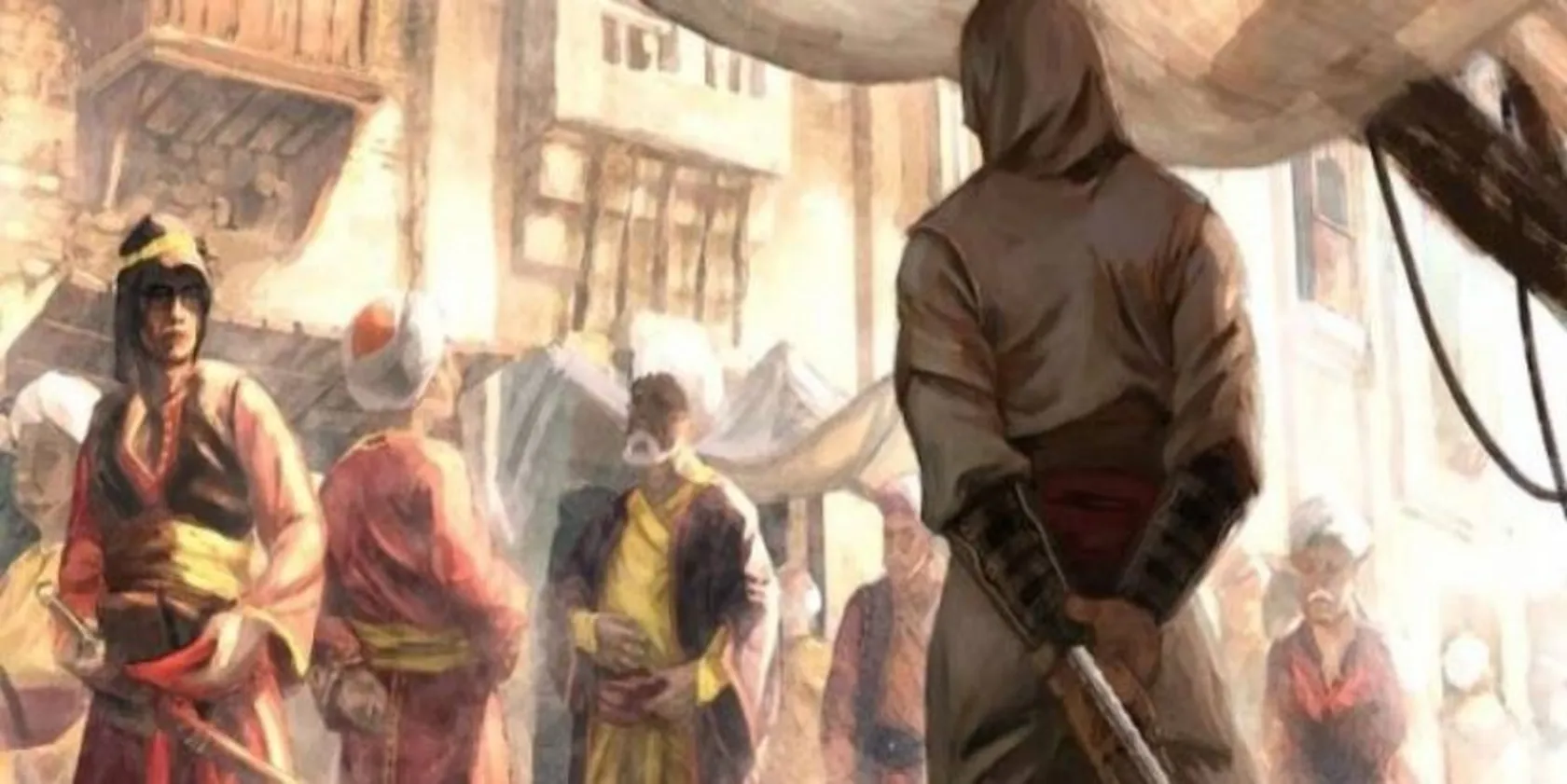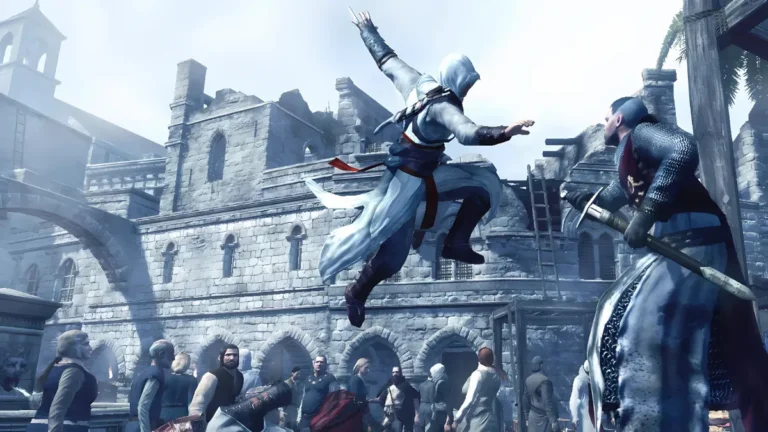Just like many iconic video game franchises, Assassin’s Creed started from humble beginnings. Most fans were first introduced to the series through Altaïr, navigating the streets of the Middle East during the Third Crusade, enjoying the game’s parkour mechanics, historical depth, and sci-fi twist. In this article, we take a look back at some little-known facts from the very first Assassin’s Creed game.
A Prince of Persia Reboot in Disguise
For those who played the original Assassin’s Creed, the parkour, climbing, and diving mechanics might have felt a little too familiar. That’s because the game originally began development as a reboot of Ubisoft’s Prince of Persia series, titled Prince of Persia: Assassin. It was meant to be a sequel to Sands of Time, but Ubisoft scrapped the idea since the story didn’t focus on the prince. The project was reshaped and eventually became the Assassin’s Creed we know today.
Based on a Real Historical Sect in Iran
Many international fans may not know this, but Iranian gamers are well aware: the original inspiration for Assassin’s Creed comes from a real historical sect based in Alamut, Iran, known as the Hashashin. Active in medieval Persia and Syria, the Hashashin were a militant group that opposed the Seljuk Turks. They trained to assassinate political and military leaders but were eventually wiped out after the Mongol invasion. The game takes heavy inspiration from their legends, although later titles have strayed far from historical accuracy.
The Connection to the Novel Alamut
The philosophical foundation of Assassin’s Creed comes from the 1938 novel Alamut by Slovenian author Vladimir Bartol. The book tells the story of the Hashashin and their leader Hassan-i Sabbah, and many key elements from it were directly used in the game. One such quote, “Nothing is true, everything is permitted,” was taken straight from the novel and remains central to the Assassin’s Creed lore. Even after nearly a century, Alamut continues to sell well thanks to its connection to the franchise.
Animus Was a Hard Sell

Believe it or not, the concept of the Animus, the sci-fi device that allows users to relive ancestral memories, wasn’t popular with Ubisoft’s marketing team. They found the idea of switching from historical gameplay to a modern narrative a bit too strange for the time. However, it wasn’t entirely new—Prince of Persia: Sands of Time also used a storytelling technique where the prince narrates past events. Over time, due to mixed feedback, Ubisoft began to reduce the Animus’s role, especially in titles like Black Flag, where it’s nearly absent.
One Face for Three Characters
Francisco Randez, the model for Desmond Miles, was also used as the face for Altaïr and Ezio Auditore. Ubisoft selected Randez through a modeling agency because of his Mediterranean look. Interestingly, both Randez and Desmond were bartenders in real life—whether by chance or intentional design, we may never know.
The Iconic Voice Behind Desmond
If Desmond’s voice sounds familiar, it’s because he was voiced by Nolan North, one of the most prolific voice actors in gaming. North has lent his voice to iconic roles like Hades in God of War, the Prince in Prince of Persia, the Penguin in Batman: Arkham Origins, and Deadpool in several games. He’s even appeared in Rick and Morty as the voice of *Scroopy Noopers.
Altaïr Could Swim (Sort Of)
One quirky detail from the original game is that Altaïr could actually swim—but due to a glitch in the Animus, he would drown. This was explained in a later cutscene by Rebecca Crane, who said the system couldn’t process swimming animations. In reality, the developers likely skipped swim mechanics to avoid complicating gameplay. Eventually, the ability to swim was added based on community feedback.
The Meaning Behind “Altaïr Ibn-La’Ahad”
Altaïr’s full name is Altaïr Ibn-La’Ahad, which translates from Arabic as “The Bird, Son of No One.” It’s a fitting name for a character raised by the Assassins without knowledge of his parentage. Birds are a recurring motif in the series, symbolizing freedom and watchfulness, which reflects Altaïr’s character perfectly.
Masyaf Is a Real City
Masyaf, the Assassins’ headquarters in the game, is a real historical city in northwestern Syria. The fortress you see in the game was actually the stronghold of the Hashashin, particularly the Nizari Ismailis. The site underwent restoration between 2000 and 2006 and was later opened to tourists. Archaeologists even discovered secret tunnels and public baths, much like what players saw in-game.
Al Mualim Was Based on a Real Person
The character Al Mualim, the mentor in the first game, is based on Rashid al-Din Sinan, the actual leader of the Hashashin in the late 12th century. Due to legal concerns, Ubisoft couldn’t use his real name in the game. However, in the Assassin’s Creed Infographics book, they acknowledged the historical figure and explained the choice of a fictional name.
Guinness World Records Held by Assassin’s Creed
Assassin’s Creed isn’t just iconic—it’s record-breaking. Here are some of the franchise’s Guinness World Records:
- Most magazine covers for a game: AC II appeared on 137 magazine covers in 32 countries (2009)
- First game to use the Anvil engine: The original Assassin’s Creed (2007)
- Longest Assassin’s Creed marathon: 109 hours by three Belgian gamers playing Brotherhood (2010)
- Largest variety of bombs in a stealth game: Over 300 in Revelations (2011)
- Shortest AAA stealth game development: Assassin’s Creed III developed in just 350 days (2012)
- Most signatures in a campaign for more playable female characters: 9,669 (2014)
- Most ships destroyed in Black Flag: Over 5.3 billion (2014)
- Best-selling pirate-themed game: Black Flag with 12.36 million copies sold (2015)
- Most platforms supported by a stealth series: 16 platforms (2015)
- Most 100% completions on PlayStation: AC II with 157,586 players (2017)
- Most Twitter followers for an action-adventure game: 4.23 million followers (2018)
- First Grammy win for a game soundtrack: AC Valhalla: Dawn of Ragnarok, composed by Stephanie Economou (2023)
